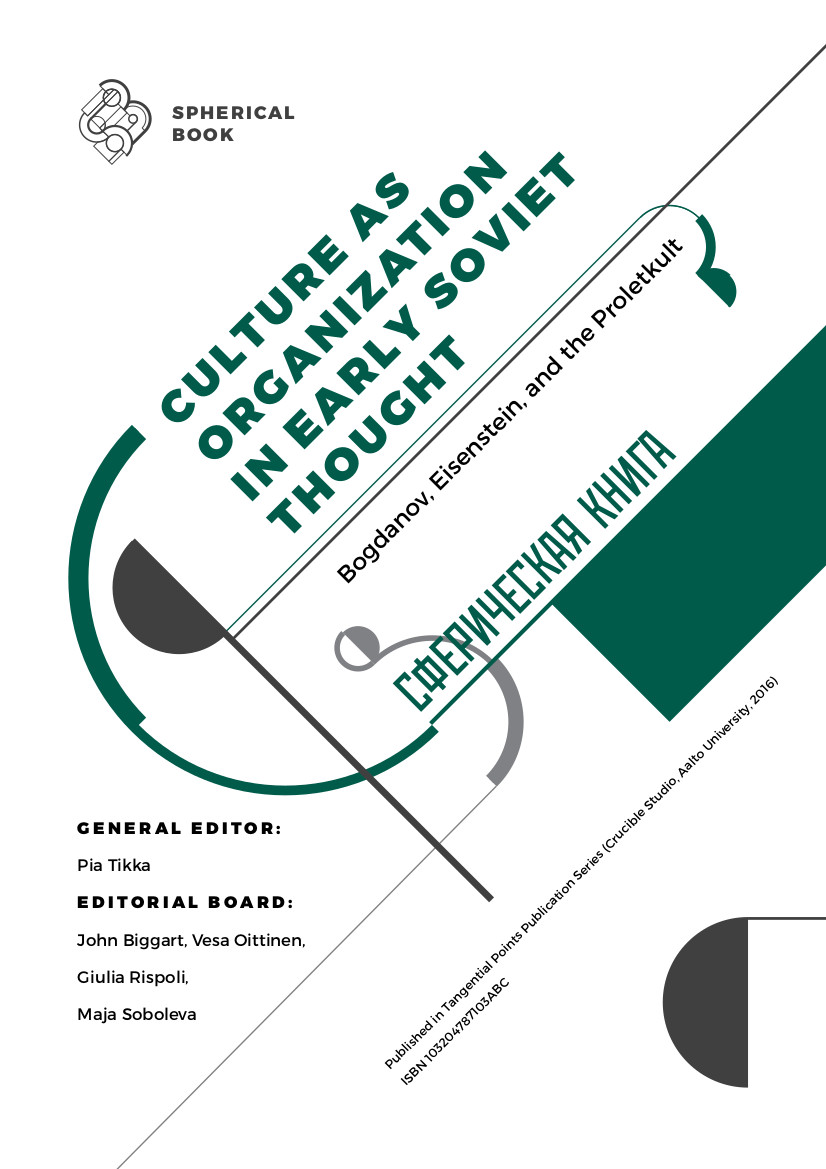Culture as Organization in Early Soviet Thought: Bogdanov, Eisenstein, and the Proletkult (2016)
Filed under book, spherical book | Tags: · cinema, film, film theory, montage, philosophy, proletkult, russia, systems theory, tektology, theory

“This anthology brings together a group of film researchers, historians, political scientists and systems scientists to discuss historical and contemporary tangential points between the sciences and the arts in Russia during the first decades of the twentieth century. All chapters provide new insights into linkages between the arts, philosophy and other disciplines during this period. Tangential points between early Russian systems thinking and approaches to montage that were being developed within the film community are examined in detail. The contributing authors focus on two thinkers: the filmmaker, Sergei M. Eisenstein and the systems theorist, Aleksandr A. Bogdanov.”
The book is published in an interactive format inspired by Eisenstein’s idea of the “Spherical Book”, organising chapters in a thematic modular way, allowing for multiple reading perspectives.
Edited by Pia Tikka, with John Biggart, Vesa Oittinen, Giulia Rispoli, and Maja Soboleva
Publisher Aalto University School of Arts Design and Architecture, Helsinki, 2016
Tangential Points series
ISBN 9789526000763
Patrizia C. McBride: The Chatter of the Visible: Montage and Narrative in Weimar Germany (2016)
Filed under book | Tags: · aesthetics, art history, avant-garde, constructivism, dada, film, montage, narrative, neue sachlichkeit, photography, photomontage, weimar republic

“The Chatter of the Visible examines the paradoxical narrative features of the photo montage aesthetics of artists associated with Dada, Constructivism, and the New Objectivity. While montage strategies have commonly been associated with the purposeful interruption of and challenge to narrative consistency and continuity, McBride offers an historicized reappraisal of 1920s and 1930s German photo montage work to show that its peculiar mimicry was less a rejection of narrative and more an extension or permutation of it—a means for thinking in narrative textures exceeding constraints imposed by “flat” print media (especially the novel and other literary genres).
McBride’s contribution to the conversation around Weimar-era montage is in her situation of the form of the work as a discursive practice in its own right, which affords humans a new way to negotiate temporality; as a particular mode of thinking that productively relates the particular to the universal; or as a culturally specific form of cognition.”
Publisher University of Michigan Press, 2016
Creative Commons BY-NC-ND 4.0
ISBN 9780472053032, 0472053035
x+236 pages
Volker Pantenburg: Farocki/Godard: Film as Theory (2006/2015)
Filed under book | Tags: · cinema, essay film, film, film criticism, film theory, image, montage, painting, photography, theory

“There is a tension between the requirements of theoretical abstraction and the capacities of the film medium, where everything that we see on screen is concrete: A train arriving at a station, a tree, bodies, faces. Since the complex theories of montage in Soviet cinema, however, there have continuously been attempts to express theoretical issues by combining shots, thus creating a visual form of thinking.
This book brings together two major filmmakers-French New Wave master Jean-Luc Godard and German avant-gardist Harun Farocki to explore the fundamental tension between theoretical abstraction and the capacities of film itself, a medium where everything seen onscreen is necessarily concrete. Volker Pantenburg shows how these two filmmakers explored the potential of combined shots and montage to create ‘film as theory’.”
First published as Film als Theorie. Bildforschung bei Harun Farocki und Jean-Luc Godard, transcript, Bielefeld, 2006.
Translated by Michael Turnbull
Publisher Amsterdam University Press, 2015
Film Culture in Transition series
Creative Commons BY-NC-ND 3.0 License
ISBN 9789089648914
285 pages
Reviews: Dietmar Kammerer (taz.de, 2006, DE), Toni Hildebrandt (Senses of Cinema, 2015), Alex Fletcher (Review31, 2015), Chiara Marchini (Medienwissenschaft, 2016).
Comment (0)
